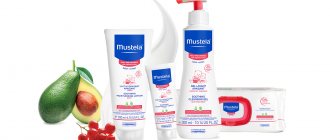General concepts about diaper rash
Diaper rash, or diaper dermatitis, is an irritation that manifests itself as redness in vulnerable areas of a baby's skin. It manifests itself as a rash, redness, itching and pain, the child is worried, fidgets in the crib, cries, sleeps and eats poorly. What are the reasons for diaper rash? Rubbing the skin against itself or against clothing, and then infecting the rubbed area. As a result, we have the result - diaper rash on the baby’s neck.
It can rub anything. Usually this is either stiff clothing, seams, or all of the above.
Diaper dermatitis occurs where the skin rubs against itself. These are places where there are a lot of folds. For example, diaper rash often appears in the folds of the neck if the child is chubby. In addition, mothers often complain of redness in the diaper area, between the baby’s fingers and toes, and behind the ears. The chest and back are not immune from them. Diaper rash in the neck area of a baby appears when the child moves his neck while sleeping or while walking - the folds rub against each other.
It is also possible for the neck to be rubbed with the ribbons of hats or a diaper. It must be remembered that children often spit up, and mothers do not always notice it. What the contact of the skin of the neck with the aggressive contents of the stomach leads to, we think, is clear to everyone. Allergies and various skin diseases that are caused by fungi or aggressive microorganisms (staphylococcus, streptococcus) should not be confused with diaper rash.
Differences between diaper rash in adults and children
To answer this question, we must briefly explain how the skin of a newborn differs from the skin of an adult. In addition to the fact that it is more tender, it also has important features. Young children have 12 times more sweat glands than adults. They begin to work only on the second or third day of life. They remain underdeveloped for up to three years. Other glands, the sebaceous glands, are very active in infants - almost like in teenagers. Infants have much more nerve endings in the skin than adults.
The skin of babies actively breathes - ten times more actively than that of adults. It also has many more blood vessels that lie closer to the surface of the dermis. This is especially noticeable in babies with thin and light skin - you will not see such a mesh on anyone else. Few people think about how important the bacteria that live on the skin are. We have so many of them that bacterial cells are several times larger than our own. Symbiotic bacteria destroy harmful microbes and form a protective layer on the surface of the skin. They also serve as scavengers, destroying loose scales and dirt. Our immunity, as well as the pH of our skin, helps us keep them in check. For us it is acidic, for infants it is neutral or slightly alkaline. Coupled with the weakness of local immunity, it turns out that microbes often get out of control. Which children are more likely to have diaper rash on the neck and other places?
If your baby is a chubby baby, be extremely careful. Such children have many folds on the skin, which collect sweat and dirt.
The baby's neck or armpits get wet. In the future, they rub, causing redness and rash on the skin. Be doubly careful if you live in a warm, humid region, such as southern Russia. It’s not easy for adults in the hot air, and even more so for kids. You remember that they sweat more actively? Babies are very prone to allergic reactions. Literally anything can cause it. New food? The most common reason. Creams, shampoos, powder with which things are washed? Easily. If you are breastfeeding, what you eat is also important . And yes, be careful with cosmetics - this also often causes allergies. Perhaps dad should change his favorite cologne too. Have you decided to save money on clothes or bedding made from natural materials? Then you will soon have to treat newborn diaper rash on the neck. Synthetics often irritate children's skin. Also, diaper rash can appear in the most unexpected places, even on the palms of a newborn.
If you swaddle your baby the old fashioned way, swaddling it too tightly can also cause diaper rash. It’s not worth talking about pets and household allergens like plant pollen. Very often, the cause of diaper rash is simple skin contamination due to improper use of powders and ointments. Diaper dermatitis often develops after a course of antibiotics. They destroy not only pathogens, but also bacteria that are important for the growing child’s body. They may be replaced by fungi and other aggressive microorganisms. As you can see, the causes of diaper rash are varied. It is not surprising that they occur in all children.
Localization of redness in babies
Diaper rash appears in the baby's skin folds in various places:
In the groin
Localization of rashes in the groin is a fairly common phenomenon in children of both sexes. In a boy, rashes may appear on the testicles; in a girl, the labia may become inflamed.
These problems are so often caused by errors in the use of diapers (for example, buying products that are smaller than the size required for the baby), that some pediatricians (Dr. Komarovsky does not support this opinion) insist on replacing store-bought diapers with diapers in which the baby’s body breathes better.
On the butt (between the buttocks)
Diaper rash between the buttocks appears if the baby remains in a disposable diaper for a long time, having managed to pee and poop more than once during this time. This also happens if the material from which the diaper is made contains substances of allergic properties.
At first, a slight redness appears on the baby’s skin, then the color of the spots becomes intense. If measures are not taken in time, the matter is not limited to redness - small pimples form on the skin.
Behind the ears
Such a seemingly safe place in terms of diaper rash can also present unpleasant surprises to parents. However, it is precisely behind the ear that the skin is very delicate, reacting to any external irritant. This could be moisture or dust accumulating behind the ear. If they are not removed in a timely manner, diaper rash will definitely make itself felt.
On the neck
The occurrence of diaper rash in the neck area is a problem for large children, whose bodies have a particularly large number of folds. They are also on the neck, and moisture may remain in them after water procedures. The child turns his head, resulting in friction and, as an unpleasant result, inflammation on the delicate skin.
If not noticed in a timely manner, it can cause the appearance of pustules. This is why hygiene in the neck area is extremely important: the skin should be dried and then lubricated with baby care products such as baby cream.
Sometimes friction is caused by laces and ties from caps and other hats. Parents need to be sure that they are not made of synthetic materials, are not rough and do not injure the skin.
Armpits
Inflammation of the skin in the armpits usually occurs due to irritation from clothing. Parents should make sure that their child’s underwear does not have rough seams (for the little ones, by the way, things are made with the seams facing out to avoid their contact with the skin). It is advisable to avoid sleeveless tank tops and bodysuits as the piping at the armhole can also cause friction under the arms.
As a preventive measure against the formation of diaper rash in this part of the body, experts recommend carrying out hygienic water procedures with a weak solution of potassium permanganate.
On the legs (below the knees, between the toes)
The cause of diaper rash in these areas is prolonged exposure to sweat on the skin. Left in the folds between the fingers or under the knees, sweat becomes a favorable environment for various bacteria.
Degree of development of diaper rash
There are 3 degrees of diaper rash:
- The first degree is mild diaper rash in a child. The skin turns red, a rash appears, and sometimes peeling. The skin remains intact. The reddened area is warmer than the rest of the skin. The baby experiences discomfort, but within acceptable limits. This form of diaper dermatitis does not require special treatment.
- The second degree is moderate diaper dermatitis. Pimples, cracks, and erosions are already beginning to appear here. Redness, and subsequently inflammation and rash, spreads in different directions, the child is restless, often starts crying, suffers from insomnia, and eats poorly. This is already a cause for concern, but nothing critical. By following our simple recommendations, you can easily cope with the problem.
- Third degree - severe, advanced severe diaper rash on the neck. This is where a secondary infection occurs. At this stage, diaper rash becomes covered with ulcers, ulcers appear, the affected areas become wet and smell bad. The epidermis peels off due to severe pain, the child is extremely restless, sleep and appetite are disturbed. The temperature rises. This is already a reason for a visit to the doctor, which is better not to put off.
Diseases with which diaper rash should be differentiated
Redness of the skin is not only accompanied by diaper dermatitis. Fungal infections (thrush, candidiasis) also often develop under similar circumstances. Infants often suffer from pyoderma (skin infection by pathogenic streptococcus). The baby is not immune from eczema.
Does your child have a sharp rise in temperature, is the reddened skin festering, has pimples or a yellowish coating appeared on it? This is a reason to suspect a fungal or bacterial infection.
If you have people in your family with allergic skin diseases - eczema, psoriasis - then these diseases can be inherited. To find out the degree of risk, consult your doctor; do not risk your baby’s health. A reason to be wary is an increase in temperature. Yes, this also happens with diaper dermatitis, but if the disease is already advanced. If there are a couple of red spots on the body, and the thermometer shows 38, this is no longer diaper dermatitis. Also try to remember whether you have given your child all the necessary vaccinations. Red spots may be signs of measles or rubella.
Cases in which specialist help is needed
Usually, diaper rash can be easily treated at home. However, there are times when you cannot do without the help of a doctor. Large area ulcers, erosions, cracks. This means that the inflammation of the skin has already gone quite far. There is a danger that a bacterial infection will occur.
In addition, it becomes difficult to help with home remedies if the diaper rash on the baby’s neck is mild, but lasts for a very long time. Diaper dermatitis usually goes away within a couple of days. Redness that lasts for a week is already a cause for concern. If you find signs of pyoderma, impetigo or fungus. In this case, your baby needs antibiotics or antifungal agents. Self-medication of diaper rash on the neck is highly discouraged. Such drugs should only be prescribed by a specialist. If you suspect measles or rubella, you may be hospitalized to reduce the risk of an epidemic.
Too many people are refusing vaccinations right now, so be careful. The health benefits of vaccinations for children are enormous, but the risks are minimal. A very high temperature, especially if it does not go down or lasts for a long time, indicates that an infection has developed. It is quite difficult for a newborn’s weak immune system to cope with even simple diseases. Don't take risks. Too much discomfort that the baby experiences - heavy, bitter crying, active scratching, loss of appetite - will bother any mother on their own. Not to mention that severe pain and itching are not typical for diaper rash.
Creams for prickly heat in children
Knowing what prickly heat looks like in newborns, mothers immediately sound the alarm and run to the doctor. This is the right decision, as the specialist makes a diagnosis and prescribes a treatment regimen. In addition to ointments and lotions, treatment of prickly heat in infants is also carried out using special effective creams.
The cream may contain the following components:
- Zinc oxide. The substance quickly dries the dermis and has antiphlogistic, regenerating, and adsorbing effects. Zinc has astringent properties, so you can quickly get rid of the rash. It promotes collagen production and takes part in the restoration of damaged tissue.
- Ichthyol. This substance is contained in many medications necessary to combat heat rash. The component is obtained from hot shale resins. It is characterized by antifungal, antiseptic, antiphlogistic, keratoplasty, disinfectant, analgesic properties. Also, the use of medications with ichthyol helps improve blood supply to the skin. Products containing ichthyol are very effective.
- D-panthenol. In the treatment and prevention of prickly heat in children, creams with the addition of this component are actively prescribed. It is a derivative of pantothenic acid. All medications containing D-panthenol are intended to accelerate the healing of the epidermis. Thanks to it, cellular metabolism is corrected, collagen is produced, acute inflammatory processes, peeling and itching are eliminated. Also, such creams moisturize the epidermis.
- Glycerol. Glycerin is usually an auxiliary component. It helps to additionally moisturize the dermis and eliminate peeling.
- Antiseptics. If there is a risk of suppuration, then drugs are prescribed, including cetrimide and benzalkonium chloride. But this group of drugs can only be used in the presence of acute inflammatory processes and are prohibited for prevention.
- Natural extracts. When treating prickly heat in children at home, creams containing plant extracts can be used. Most often these are extracts of string, calendula, oak bark, nettle, mignonette, and chamomile. Such components help eliminate skin itching, acute inflammatory processes, and peeling of the skin. Children's skin is soothed, moisturized and nourished with beneficial microelements. The blisters dry out very quickly, and the wounds heal.
- Vitamins. Most of the anti-sweating remedy contains vitamins A, E and C. Vitamin A has a good effect on the skin, eliminating acute inflammatory processes, normalizing blood circulation, and helping to accelerate the regeneration of damaged skin areas. Vitamin E is characterized by calming and antiphlogistic effects. Thanks to it, the skin does not dry out, and local blood circulation is normalized. Ascorbic acid takes an active part in the regeneration of the dermis. Thanks to vitamin C, collagen production is noted and the overall resistance of the epidermis increases.
Before purchasing and using this or that product, if symptoms of miliaria appear in children, treatment and prevention, you should consult a pediatrician or dermatologist.
Preventing diaper rash
The most important thing: the baby's skin should not be wet and should breathe. There are special talc-based powders, but they are often abandoned. If you apply them to skin that is not dry enough, they will form lumps. Finding themselves between the folds of a newborn’s delicate skin, they rub it, and instead of preventing diaper rash on the baby’s cover, we provoke them. Clothing and bedding should be soft, comfortable, not tight, and loose.
When choosing a material when sewing or buying clothes and bed linen, you need to select natural raw materials. If you wash with a softener, make sure it is suitable for children's clothes. If you use only powders, then for children's things you need powders of special children's varieties. The baby's clothes should be soft and made from natural, not synthetic materials. Eliminate all possible allergens, replace foods or materials that cause redness and rashes on the skin.
Wipe your baby's neck dry with special wipes if he is sweating. Wash your baby regularly and then dry with a soft towel. Air baths are very useful. Let the baby remain without clothes for at least an hour. If the weather permits, then in the park or in the garden, but you can also do it at home.
The most common mistakes when treating diaper rash
It is often recommended to use plant-based powders, starch, and baths with chamomile tincture. It's better not to do this. Plant substances can be a strong allergen, aggravating the problem instead of treating it. You need to be more careful with starch, it rolls into lumps. This greatly irritates the skin, which is already damaged. Such powders increase the likelihood of infection. Avoid treating diaper rash with fat-based ointments and oils.
The skin must breathe. Oils do not give her this, forming a film, and they again may be allergenic. Aromatherapy for calming a baby is very controversial. The aroma of lavender or valerian will quickly help the child calm down and fall asleep, but, as already mentioned, the result can be an allergy.
Do not try to get rid of diaper rash yourself if it has reached an advanced state. Your baby will get help in the hospital.
Caring for a baby with diaper rash
First of all, avoid warm and dry air. This may seem strange to you, but doctors know: the body performs work even when at rest. Heartbeat, peristalsis, breathing, sweating never stop, right? In a dry, warm microclimate, the baby's body spends a lot of energy trying to cool down and hydrate. Therefore, he begins to sweat profusely, aggravating the situation. Dryness and excess moisture contribute to the appearance of diaper rash in infants.
The nursery should be moderately cool. Are you swaddling your baby? Wash diapers with antiseptic and dry in fresh air. Don't forget about air baths. Ventilate the room regularly. If your child is overweight, reconsider their diet. The artificial animal must be switched to a special hypoallergenic mixture.
Bathing is necessary for the baby; add a little potassium permanganate solution to the bath. Place a few (five is enough) crystals of potassium permanganate in a jar or mug, dilute with water, and shake. Express what happens through gauze into the basin where you will bathe the baby. The water should take on a pinkish tint. Be careful: undissolved potassium permanganate crystals are aggressive and can cause burns. Keep your baby in the water for a few minutes, then pat dry thoroughly.
Iron things not only from the outside, but also from the inside. Clothes should not be too rough. Pay attention to prints and stripes: they should not be embossed, the inside of the clothing should be smooth. When diaper rash has developed against the background of exudative-catarrhal diathesis, try Suprastin or 1% hydrocortisone ointment.
Folk remedies
Traditional medicine is used as an auxiliary element of therapy for children's heat rash. Particular emphasis should be placed on the use of medicinal plants that have a drying effect. It is recommended to add decoctions and infusions to the bath, as well as to wipe, wash, and apply to the areas affected by the rash.
The following tools have proven themselves to be effective:
- Infusion of chamomile with a series of tripartite. This collection has anti-inflammatory, drying, antiallergic, analgesic and antiseptic properties. To prepare it, you need to take equal parts of chamomile herb and crushed string roots. 2 tbsp. l. The herbal mixture should be brewed with half a liter of boiling water, cover the container with a lid and leave for a quarter of an hour. After cooling, the infusion should be carefully strained. Add the resulting liquid to the baby’s bath water.
- Decoction of oak bark. Pour 20 g of crushed oak bark into 1 liter of boiling water. To make the hood stronger, you need to simmer the mixture in a water bath for 20-30 minutes under a closed lid. Filter the resulting broth well and pour it into the child’s bathing water.
- Decoction of bay leaf. Pour 15-20 whole laurel leaves into 1 liter of water and boil. Simmer over low heat for a quarter of an hour, then leave covered for another half hour. As in previous cases, you need to carefully strain the resulting broth. It is also used as an additive to bathing water.
- Alcohol tincture of chamomile. Suitable for the treatment of prickly heat and diaper rash in children over 3-4 years old. But the extract is not used in its primary form: 4 tbsp. l. The product must be diluted with 0.5 liters of hot water. Leave for half an hour - during this time the solution will have time to cool. It is used for rubbing or applying to problem areas of the skin.
- Soda solution. Boil a glass of water, cool slightly and add 1 tsp. soda Stir until it is completely dissolved. Soak a clean cloth or gauze in the resulting product and then apply it to the areas affected by prickly heat.
- Starch mixture. Mix 1 part potato starch with 2 parts water and stir well. After bathing the child, it is necessary to pour the prepared solution over it, which does not need to be washed off afterwards.
Starch is also great when used as a homemade powder. This will be an express method of dealing with the problem when there are no other means at hand to eliminate diaper rash on the child’s body.
If your doctor allows it, you can add potassium permanganate powder to your bathing water. The solution should be light and weak, otherwise the child will get burns. Having lowered her hand into it, the mother should see it clearly. Only in such a liquid can a child be subsequently immersed.
Treatment of diaper rash on the neck of a baby
Medicine knows enough ways. how to get rid of diaper rash in newborns. The first thing to remember is that stage 1 diaper rash does not require treatment. In the vast majority of cases, they go away on their own. If they do not want to go away, pay attention to the following medications:
- Special products to protect against damage to the skin of a child. Among them is Drapolene, which is made from ammonium compounds. They have antiseptic and disinfectant properties. Apply Drapolene three times a day to the affected area. Before doing this, you need to wash and dry it very carefully.
- Bepanten has also proven itself well. Its active ingredient is bepanthenol. In the body it is converted into pantothenic acid. This is an important component for the restoration of the skin and mucous membranes, the symptoms of diaper rash go away.
- Talking agents based on talc or zinc hydroxide, which can be prepared in pharmacies, are becoming a thing of the past, but are sometimes still used. Why, we have already written above.
- Tannin or methyluracil ointment, as well as Vitamin F99 cream. It is better to use them only as prescribed by a doctor.
- Finally, in the third stage of the disease, ultraviolet radiation helps well.
How to treat complications of diaper rash? The pustules are dried with brilliant green or blue. Weeping wounds are treated with solutions of substances such as Tannin, silver nitrate, Rivanol (use only after consulting a doctor).
When the diaper rash stops getting wet, you can use bactericidal or antifungal ointments. Remember: damaged skin always needs to breathe. This means that you should not use greasy ointments or oil emulsions.
Running around neighbors asking what and how they treated diaper rash is a bad idea. Better consult your doctor. Grandma's advice can also do more harm than good.
Treatment
Untimely treatment of prickly heat can lead to:
- the appearance of wounds that become scars;
- purulent discharge due to infection;
- swelling and severe inflammation;
- increased temperature and lack of appetite;
- sometimes causes pyoderma.
Miliaria will have to be treated comprehensively, using proven folk remedies and drugs that alleviate symptoms. The types of local drugs prescribed for treatment are different.
Creams
Creams are not particularly popular due to their oily base, which does not allow air to pass through well and does not allow the skin to breathe. It also happens that the application of this product provokes the appearance of a larger affected area. However, among them there are irreplaceable helpers in the fight against diaper rash.
Creams commonly used in treatment:
- Eared Nanny under a diaper.
- Depantol.
- Sudocrem.
- Desitin.
Rules of use:
- Wash the affected area with warm water without using soap or other means, pat dry with a towel.
- Apply the cream to the prickly heat and let it absorb for 1-2 minutes.
- Put a diaper and clothes on the baby.
- When swaddling, use the loose method.
- Carry out the procedure 2 times a day or after each wash until the symptoms disappear completely.
Ointments
More preferable remedies in the fight against heat rash, since they do not clog pores too much and are better absorbed:
- Bepanten.
- Zinc ointment.
- Distin.
- Pantestin.
The rules of use are the same as for creams.
Oils
When treating prickly heat, do not use oils. Even if they are intended to moisturize the skin of infants, they should be avoided during the treatment of the disease. Indeed, in addition to their nutritional functions, they cover the skin with a thin film, which can cause pimples or aggravate an existing problem.
Chatterboxes
Chatterboxes are weak suspensions based on alcohol, boric or salicylic acid, decoctions and tinctures of plants. They have good penetration into the surface layers of the skin, accelerate cell regeneration, and reduce inflammation.
For newborns, it is better to use the drug Tsindol or order the formula at the pharmacy and use it according to the instructions:
- Before use, test for an allergic reaction on a small area of skin.
- Apply to cleansed affected skin with a cotton swab or cotton pad;
- Allow to dry (a white residue may form on the skin).
- After 2 hours, rinse with warm water.
- The duration of treatment depends on the extent of the damage.
Powders
Products based on talc, which absorbs excess sebum well and reduces friction.
Due to this, the healing of the skin is accelerated:
- Apply powder to palms and rub.
- Apply with light patting movements to the baby's skin.
- There should be a slight whitish coating left.
- Apply 2 times a day or every time after washing.
During treatment, it is necessary to refuse the diaper for as long as possible if the affected area is the butt and groin area. Also, do not rub damaged areas. It is necessary to maintain the cleanliness of the room and those objects with which the child comes into contact.
Why do children get diaper rash?
Diaper rash in newborns is a skin irritation accompanied by local redness and inflammation, which most often affects children aged 2-3 weeks to 12 months. Diaper rash can appear under the influence of factors such as:
- mechanical impact - friction of the skin against the diaper, due to uncomfortable underwear or incorrectly selected clothes;
- contact with irritants, for example, enzymes in urine and feces;
- prolonged contact with moisture - the child often sweats or his skin is not sufficiently wiped after bathing;
- overheating - the newborn is dressed too warmly or is in a hot room.
The reasons why diaper rash often appears in a child under 1 year old lie in the structural features of the baby’s skin.
The top “protective” layer of human skin is called the stratum corneum. In children, it has a very small thickness, which increases sensitivity to various kinds of irritants and microtraumas occur more often.
The space between the cells that make up the stratum corneum is filled by a lipid-protein structure, which is also called the lipid barrier. This barrier represents the skin’s natural protection from environmental influences. In children, it can be destroyed due to frequent bathing, improper selection of hygiene products, or simply during active movement. Moreover, the pH of the skin of newborns normalizes closer to 3 months - until this age, relatively low acidity does not protect well from possible inflammation 1.
Causes
The occurrence of severe diaper rash in a child's groin can be caused by various factors. A special place is given to the rules of hygienic care, which are not observed. Diaper rash in newborns between the legs can be caused by the following factors:
- Late diaper change. Urine and feces have a negative effect on the dermis, which causes irritation.
- Wrong selection of diapers. Fragrance additives used by manufacturers can have an irritating effect on the delicate skin of infants. Diaper rash also appears between the legs of newborns if the size is incorrectly selected.
- Insufficient care of the genitals.
- Allergic reactions to the material from which the diaper is made.
- Wrong diet. A common cause of irritation in the groin is incorrectly chosen products for introducing complementary foods.
- Personal intolerance to certain foods that the mother consumes during lactation.
- Temperature violation.
- Very dry air in the room where the baby most often stays.
- The presence of infectious pathologies.
In infants, the appearance of irritation in the groin is often associated with the introduction of complementary foods. When new foods are introduced, the composition of the stool changes, and the urine also changes. If the diaper is not changed on time, waste products have an irritating effect on the baby’s epidermis.
Diaper problems
Quite often, diaper rash between the legs of a newborn appears due to ill-chosen diapers. Main reasons:
Poor quality diaper. Diapers often provoke an allergic reaction. If irritation only appears under diapers, then you should try changing the brand. A diaper that was too wet and was not changed on time. Feces and urine upon contact with the skin provoke itching and burning, and diaper rash. They need to be changed every 3 hours. The diaper does not fit correctly and, when moving, rubs against the baby’s dermis, which causes discomfort.
It is important to ensure that all folds in the diaper are smoothed out.
If all the rules are followed, then the reason must be sought elsewhere.
Poor quality clothes
Diaper rash in a baby's groin can also be caused by low-quality materials from which bodysuits, men, and bedding are made. Over time, banal prickly heat easily develops into diaper rash.
The delicate skin of infants can cause irritation and internal seams, labels and tags
It is important to take care of children's clothing so that there are no parts that will cause discomfort.
Allergy
There are many factors that trigger allergies in babies. It can be:
- Some foods in a nursing mother's diet can provoke allergic reactions. Banal irritation develops into severe diaper rash in the child’s groin, which will not go away without eliminating the cause.
- The introduction of complementary foods often causes allergies, which is manifested by diaper rash.
- Allergies are also often triggered by cosmetics that parents use when caring for their baby.
The irritation will go away when the allergen causing it is identified.
Overheat
Severe diaper rash in a child's groin can be caused by improper temperature conditions. The problem is this:
- If the room where the baby is constantly located is hot enough, then it overheats. This becomes the main cause of diaper rash. Also the cause is hot weather outside.
- Wrapping a child up tightly leads to problems with the epidermis. Parents worry that the child will be cold, and begin to bundle up like cabbage. This is a big mistake every parent makes. A child cannot be wrapped up either on the street or at home.
Having established a normal temperature regime, diaper rash will also go away.
Symptoms of varying degrees of diaper rash
Diaper rash (or diaper dermatitis) in a child has 3 degrees of severity, each of which is characterized by its own symptoms 2:
- 1st degree - slight local redness. Most often they are localized in the folds of the skin (in the groin, armpits, arms and legs, neck), between the buttocks and in the lower abdomen, where the elastic band of the diaper is located. When they appear, the child is most often calm, there are no signs of discomfort, the skin is not damaged;
- Grade 2 - in addition to redness, microcracks appear on the skin. In this case, the redness is more pronounced, traces of erosion are noticeable, and rarely, small pustules. At this stage, the baby becomes restless, may reach out with his hands to irritated areas of the skin, be capricious during hygiene procedures, putting on a diaper;
- Stage 3 - the most severe diaper rash. Erosion and redness intensify at this stage, and the cracks begin to become wet. The skin becomes covered with ulcers and small ulcers. They cause pain and itching that interfere with the child's ability to sleep, eat, and play.
If you notice severe symptoms of diaper rash, you should consult a pediatrician, because such irritation can easily be confused with more serious diseases, and only a doctor can make an accurate diagnosis, as well as prescribe treatment that is safe for the baby.
How to deal with first degree diaper rash
With the first degree of pathology, treatment as such is not required - there is no need to use medications, and there is not always a need to even show the baby to a pediatrician. As a rule, changing the principles of caring for a child’s skin quickly changes the situation towards recovery.
But there is a danger that the disease will return. If the baby is truly overweight, then the problem may recur. Therefore, it is important to monitor his diet and find out the reason why the child is so large. Naturally, overweight children need more careful hygiene than ordinary children.
By the way, an air bath is the best treatment for first-degree diaper rash. It's simple: after the necessary hygiene procedures, the child must be placed naked on a safe surface. So he should frolic for some time - at first 5-8 minutes, then the time increases to half an hour. In this case, the room first needs to be ventilated so that such a “bare-butt walk” is as useful as possible. And in order to avoid excesses of the bed, under a blanket or sheet, use a special oilcloth diaper on a cotton basis.
How to distinguish diaper rash from other diseases?
The main method for diagnosing diaper rash is visual inspection. It is performed in the hospital by a pediatrician or dermatologist. When the problem is accompanied by any complications, scraping and bacteriological culture may be prescribed. Parents of small children can easily confuse the 3rd degree of severity of diaper rash with other diseases - dermatitis of various natures, infectious and fungal diseases, so it is important to know the main differences between diaper rash and other diseases.
For diaper rash 2-3:
- irritation is localized in skin folds and where there is friction with clothing or a diaper. An allergic rash can appear in other places, for example, on the face, back, chest;
- at the earliest stage, the skin becomes pink or slightly red. This condition may persist for several days and disappear on its own with proper care. In infectious diseases, changes are more pronounced and do not go away without specialized treatment;
- the edges of the affected area are usually jagged and without clear boundaries. Skin lesions due to infectious diseases may look different. For example, with lichen, the affected areas have clear raised contours and slightly lighter areas in the center;
- redness with 1–2 degrees of diaper rash does not bleed; there are no nodules or rashes that occur with allergic dermatitis;
- The appearance of diaper rash occurs without the increase in temperature that usually accompanies rubella, roseola and other childhood diseases.
It is important to remember that if you have problems with your baby’s health, even if they seem minor at first glance, you need to consult a doctor. It is not advisable to use any means independently and without his recommendation, since not all of them are suitable for young children.
Treatment options
Heat rash in infants, when the form is not advanced, can be easily treated with herbal baths, weak solutions of potassium permanganate or powder. In cases where the inflammatory process is extensive and more serious, the following types of ointments and creams are used:
- "Bepanten";
- "Drapolene";
- "Sudocrem";
- "Purelan";
- "Desitin";
- "Sanosan."
The instructions for use or the treating pediatrician will tell you how to treat miliaria in newborns with these medications.
"Bepanten"
Miliaria in children is effectively treated with the help of such a remedy, “Bepanten”. Its main therapeutic component, dexpanthenol, helps relieve irritation and inflammation, and starts the process of tissue regeneration.
Bepanten helps relieve irritation
The ointment can be used up to two times a day. It is applied in a thin layer to previously cleaned, dry areas of the skin.
"Bepanten" belongs to the category of safe drugs and has virtually no contraindications for use. Usually the product does not cause allergic reactions and is well tolerated by infants.
"Drapolin"
Parents who do not know how to treat heat rash in children should pay attention to this cream. The drug belongs to the group of topical antiseptics, the main active ingredient of which is benzalkonium chloride.
Drapolene softens the skin
"Drapolen" can also be used for both the treatment and prevention of prickly heat. Before using the product, the baby's skin must be washed and dried. The cream is applied in a thin layer with light, careful movements. In case of severe heat rash, it can be used up to three times a day. Use the product until there is complete relief from redness and rashes.
Diaper rash and prickly heat in children can be treated with this remedy only at the initial stages of their development, when the inflammatory process has not had time to affect the deeper layers of the skin.
"Sudocrem"
It is also possible to treat heat rash in infants using this cream. It has antifungal, astringent and anti-inflammatory effects. It contains three active ingredients that actively fight even severe diaper rash.
Sudocrem helps to cope with heat rash
The heat rash in babies goes away very quickly with the help of this drug, provided that the rules of hygiene are followed and the product is used for the entire period until the symptoms disappear. How long it will take to treat dermatitis depends on the severity of the skin disease.
“Sudocrem” not only helps relieve inflammation and tissue regeneration, but also carefully cares for delicate skin, carefully nourishing and moisturizing them.
"Purelan"
For heat rash in newborns, treatment can be carried out with the help of Sudocrem cream, which is also used for therapeutic and preventive purposes when cracks appear in the nipples in nursing women.
Purelan does not cause allergies
The drug is hypoallergenic, so it can be used without risk to the baby’s health.
"Desitin"
Treatment of prickly heat in children is often carried out using a drug such as Desitin. The medicinal properties of this ointment are determined by its main active component zinc oxide, which has an anti-inflammatory, regenerating and astringent effect on the affected areas of the skin.
Desitin copes well with minor skin damage
Desitin is used to treat inflamed areas up to three times a day. The product must be applied in a thin layer to clean and dry surfaces.
If an allergic reaction to zinc oxide occurs, it is recommended to immediately discontinue the product and consult a doctor.
"Sanosan"
If a mother does not yet know how to get rid of heat rash in her baby, then she should pay attention to this cream. The drug was specially developed for children, taking into account the characteristics of delicate and sensitive skin.
The product contains a large number of natural ingredients, including milk proteins, panthenol, and vegetable oils. In addition to them, the cream contains zinc oxide, which provides anti-inflammatory, astringent and regenerating effects.
Sanosan has a protective effect
"Sanosan" is a hypoallergenic drug, so it can be used in therapy even in problem children suffering from diathesis and allergic dermatitis.
Possible complications
Diaper rash is easy to treat if you pay attention to it in time. It is important to understand that irritated skin in young children, especially if wet areas and microcracks appear on it, is very sensitive to negative external factors. If parents ignore the problem or ignore the pediatrician's instructions, this seemingly minor problem can cause complications. Among them are 1-3:
- bacterial infections - damage by streptococci and other microorganisms, causing pustules and ulcers;
- fungal infections - candidiasis in the genital area, groin and anus.
Moreover, with severe diaper rash, the child becomes very restless. Painful sensations, itching, burning and discomfort with every movement do not allow the baby to eat normally, interfere with sleep and spoil the state of health even in a state of play or rest.
What to do?
For first degree diaper rash, 1-3 are recommended:
- choose the optimal hygiene products - refuse reusable diapers and diapers that cause irritation, change the brand of diaper if diaper rash appears from a diaper;
- provide proper care - thoroughly wash the baby, dry the skin completely, make sure that air is regularly supplied to it;
- eliminate overheating - the child should not be hot during rest or active play; it is also important to regulate the air temperature in the room where he spends most of his time;
- choose suitable clothes - if redness appears on the neck or armpits, you can only put on the child things that will not rub or put pressure on the problem areas.
At this stage of treating diaper rash, products that reduce irritation and naturally restore the skin 2 have proven effective at this stage of treatment - for example, Bepanten Ointment. Thanks to the high content of 4 natural lanolin and provitamin B5, Bepanten ointment gently stimulates the restoration of damaged skin and its natural healing. This product creates a reliable protective barrier that reduces the aggressive effects of irritating substances in feces and urine, while allowing the skin to breathe 2. An additional advantage of the product is its high safety profile: it does not contain dyes, parabens and other components that could be dangerous for the baby. To combat diaper rash, Bepanten ointment is recommended to be used when the first signs of redness appear, applying it every time you change a diaper 2-3.
If diaper rash has progressed to degree 2 or 3 of severity, a doctor should prescribe appropriate treatment, based on the individual characteristics of the child and his current condition. A specialist may recommend the use of ointments to restore and protect the skin, drying compresses, medicinal baths with herbal decoctions and other additives. To achieve a positive effect as quickly as possible, an integrated approach will be required. Parents will need to not only take the measures recommended by the doctor, but also make adjustments to the child’s care regimen.
Home Remedies
There are a number of home remedies that are quite effective in the complex treatment of prickly heat.
Soda lotions
Baking soda is a universal remedy that effectively fights for the beauty and cleanliness of the skin.
To prepare you need:
- 200 ml warm water;
- 2 tbsp. l. soda
Dissolve the soda in water, stirring the mixture well. The resulting solution is used to treat the affected areas of the child’s skin at least five times a day. After the skin has been treated, a special moisturizing cream is applied to it to speed up healing.
Bay decoction
Bay leaf has long been known as an excellent antiseptic and antifungal agent.
Cooking method:
- Boil 1 liter of water in a saucepan.
- Throw 15 pcs. bay leaf.
- Boil over low heat for about 20 minutes.
The cooled broth is added to the baby’s bathing water, in which the child is bathed for about 20 minutes. The course of treatment with laurel is designed for 10 days, but after just a few procedures the baby becomes noticeably better.
Infusion from the series
Effectively relieves itching, irritation, unpleasant symptoms and redness.
To prepare you will need:
- 1 liter of water;
- 5 tbsp. l. successions.
Place the dried herb in a jar and pour boiling water over it. We insist everything for half an hour. Add this infusion to the bath and bathe the child in it for 30 minutes.
Chamomile decoction
Chamomile is rightfully considered a storehouse of health. Skin problems are another area where this wonderful green healer can help.
To prepare chamomile infusion you will need:
- 250 ml water;
- 2 tbsp. l. pharmaceutical chamomile.
The decoction must be prepared in a water bath for half an hour. The cooled liquid is used to wipe skin with prickly heat.
Potassium permanganate, salt, iodine and starch protect health
A slightly diluted solution of manganese is well suited for getting rid of prickly heat. To do this, you need to prepare a pink solution in a small container. Pour the prepared liquid into the bath in which the child will bathe. Manganese has a drying effect, so it must be used carefully.
Water-salt compresses help dry out inflammation and relieve itching of the skin. You need to dilute the salt in boiled water. Use gauze to wipe off the inflammation several times a day. Iodine solution: a cotton swab dipped in an aqueous solution can also effectively and safely help a child with prickly heat. It’s easy to prepare: drop a few drops of iodine into a glass of water.
Among folk remedies, potato starch also copes well with rashes. Pour 90 g of starch into a glass of boiled water. This mixture should be poured into a bathtub with water and bathed the child. Without rinsing or drying, you need to let your baby's skin air dry. Potato starch can be used effectively for prickly heat as a powder.
Prevention
To prevent diaper rash from returning, it is important to provide the baby with proper care 1-3.
Hygiene
Feces and urine contain aggressive substances that irritate the skin. If they come into contact with the skin for a long time, irritation increases. That is why, to prevent diaper rash, you should give preference to disposable diapers that can quickly absorb moisture. In addition, diapers must be fully appropriate for age and weight. It is recommended to change diapers as they are full, taking air baths in between. It is important to monitor how the skin reacts to the diaper - this will allow you to promptly exclude an allergic reaction to materials or impregnations.
Bathing
When washing and bathing, it is necessary to use hypoallergenic products created specifically for newborns. After water procedures, the child’s skin must be thoroughly dried. If diaper rash has already appeared, you should not rub it: excess moisture in the skin folds should be removed with delicate movements, blotting with a cotton diaper or soft towel.
Caring for a child's things
An allergy to the powder or conditioner can make diaper rash worse. Therefore, it is recommended to give preference to safe household chemicals that correspond to the specific age of the baby.
Choice of clothes
Increased sweating is one of the main factors causing diaper rash, because overheating makes the skin more sensitive to irritation. You need to dress your child according to the weather, do not bundle him up for fear of hypothermia. It is also better to choose clothes that are loose, but not baggy. Things should be made of natural and soft fabrics.
Are you bathing your baby correctly?
As practice shows, diaper rash on a child’s neck also occurs due to improper bathing of the baby. It would seem that the process is simple, regular and should not cause any difficulties for moms and dads. But they still happen.
Recommendations from pediatricians regarding the rules for bathing infants:
- Bath. For the first two to three months, the child should be bathed in a small plastic bathtub; do not rush to give him swimming in a large bathtub, as well as joint child-parent bathing. Everything has its time. While the baby is comfortable in such a cramped space, a large bathtub sometimes even frightens the child. Finally, a small bath is easier to keep clean - and in this regard, you should be completely confident in the safety of water procedures.
- Water thermometer. At first, it will definitely be useful to parents, only then they can feel the desired water temperature with their hands. Recommended values are 37 degrees. And in the future, the thermometer will be useful if you want to properly harden the baby. And hardening is a huge, irreplaceable contribution to the baby’s health.
- Soap. Use standard baby soap. But you don't need to use it all the time. You should not wash your baby with soap more than twice a week. Also, the baby does not need washcloths and sponges at first, because his skin is still quite vulnerable. Simply lather your hand and lightly rub it over your baby's skin. If you still doubt this option, purchase a special mitten for washing your baby. Gels and shampoos should not appear in the bathroom until the child is 3-4 months old. You can do without them for a long time.
- Towel. Naturally, each family member should have their own towel, and the baby first of all. It should be a very soft large towel so that the baby can be wrapped in it. Choose white or light models (textile dyes are of no use to your baby’s skin).
- Hammock or slide. These are devices for water procedures that make the bathing process safe and comfortable for the baby.
Pediatricians also recommend doing a light massage before bathing. When you gently pat and stroke your baby's skin, blood supply to the muscles and epidermis improves. And the benefits of such actions will be double if immediately after the massage you proceed to bathing. Of course, all massaging movements of an adult should be light and careful. The baby should not cry or scream. If he finds himself overstimulated in the bathroom, this is not a normal situation.
For attentive parents, diaper rash does not become a problem. If you see redness on the neck, quickly take action, eliminate all provoking factors, the inflammation will go away. Remember that cervical diaper rash is often caused by the baby being overweight and you may need to focus on correcting this problem.
source











